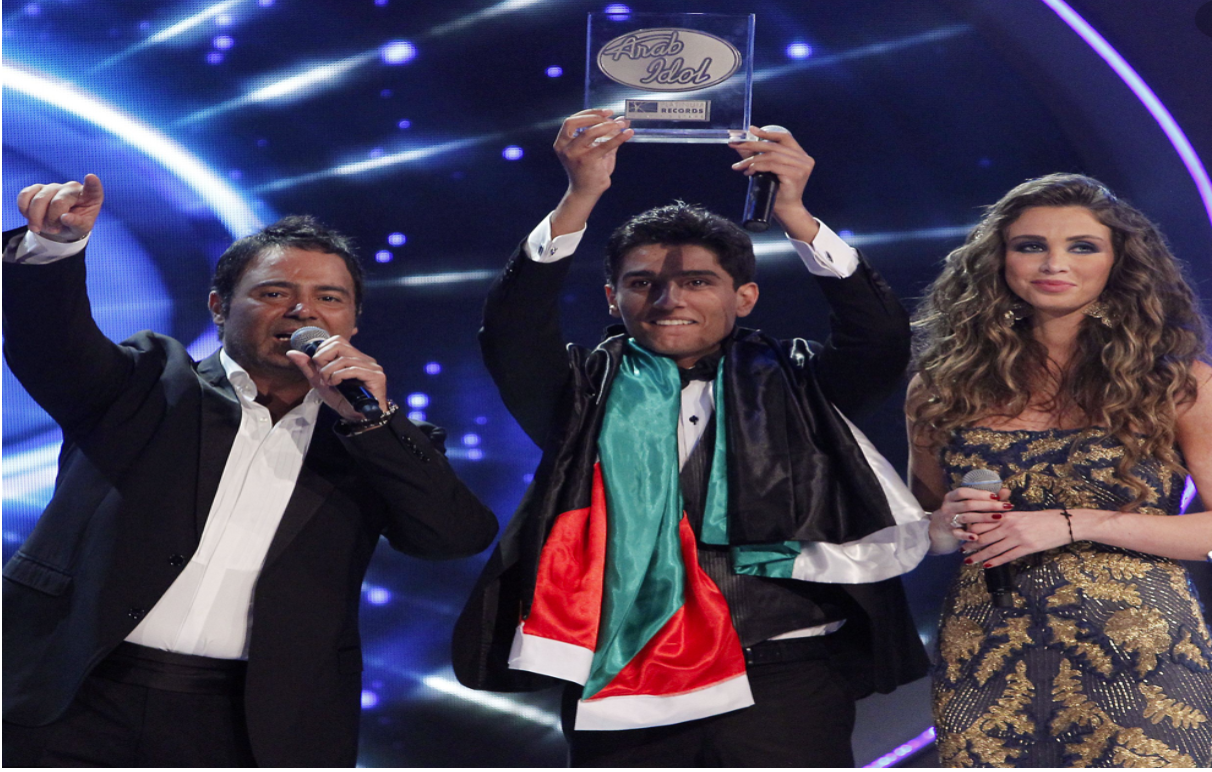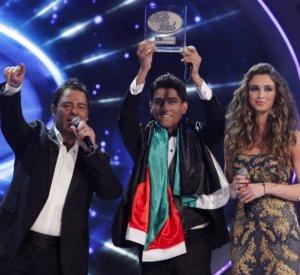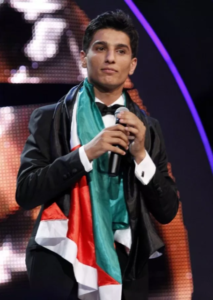
Does Palestine Need a Tarab Icon? A Short History of Mohammad ‘Assaf
If the Palestinian people were to sit down to pick an anthem, a contender would certainly be Fairuz’s 1967 song Zahrat al-Mada’in, translated loosely into English as “A Flower Among Cities.” Tonally, it sounds a bit like Queen’s Bohemian Rhapsody: a slow somber rise that later bursts into a militaristic chant, with vocals flying all over the place. It is an ode to Jerusalem, tying together Christian and Muslim narratives of the city, lamenting its loss and calling for its liberation. Like many songs on the Palestinian struggle, it never mentions Israel or the occupation of Palestine outright, but it is clear that the Jerusalem Fairuz speaks of is the Jerusalem snatched away in 1967. However, there is a subtext to Fairouz’ classic: despite its strong association with the Palestinian cause, Zahrat betrays a sense of Lebanese nationalism, specifically one that asserts a Maronite Christian identity. This is Lebanon, post-colonialism: different religious communities are being pitted against each other with extreme political consequences. The Rahbani Brothers, Fairuz’s composers (and also her husband and brother-in-law), used such musical themes in Zahrat al-Mada’in and Fairuz’s other work during the 1950s and 1960s, evoking southern Lebanon: they performed what the Lebanese called “mountain music,” affiliated with Maronite Christians of the region. This Maronite vision of Fairuz’s identity was also betrayed in her dress; at the debut of the song during the iconic Ba’albeck Festival in 1967, she and her choir were dressed in a style that echoed that of the Phoenicians, another element of the myth-making of modern Lebanon.

Even if the song has non-Arab (even anti-Arab) streaks running through it, it is still claimed by the Palestinians as a symbol of their resistance; it is a Palestinian song. And despite their other politics, Fairouz and the Rahbani Brothers were vocal proponents of the Palestinian cause from the 1950s onwards, as documented by historian Christopher Stone. Palestine has named other icons, but most come from within its own bloodlines. While it might be fashionable to speak out for the Palestinian cause in many circles, the most likely to do so in brassy artistic fashion are still Palestinians; from the diaspora, from the Palestinian Territories, and from those who hold Israeli citizenship.
“Even if the song has non-Arab (even anti-Arab) streaks running through it, it is still claimed by the Palestinians as a symbol of their resistance; it is a Palestinian song.”The deaths of the poets Mahmoud Darwish in 2008 and Samih al-Qasim in 2014 attest to a rich history of poetry and its popular audience in Palestinian contexts; Darwish’s funeral pulled thousands of mourners in Ramallah, as did Qasim’s, including a delegation from the Israeli-occupied Golan Heights. But their star did not rise as quickly or as publicly as Mohammad ‘Assaf’s did in 2013. Part of this was due to circumstance: ‘Assaf’s sheer luck to live in the age of the viral overnight sensation, facilitated by the internet. He also owes his success to a much older medium: the television. He came to Palestinian, Arab, and even global audiences primarily through his participation and eventual victory on the television show Arab Idol. The fact that it was Arab Idol is not unimportant: Arab Idol is not like other shows in the (Insert Country/Language)-Idol family, like, say, American Idol. It has the same format– the participants sing, the judges make comments both fair and unfair, the viewers vote, repeat– but it is Arab Idol’s songbook that makes it distinct. It does indeed feature the boppiest hits of recent Arabic-language pop, but it also draws heavily on the classical Arabic songbook, which in some seasons makes up to 60 percent of its offerings. These are the songs made popular by the phonograph and radio in the 1920s-1970s, belonging to a genre of music broadly described as tarab.
“The deaths of the poets Mahmoud Darwish in 2008 and Samih al-Qasim in 2014 attest to a rich history of poetry and its popular audience in Palestinian contexts; Darwish’s funeral pulled thousands of mourners in Ramallah, as did Qasim’s, including a delegation from the Israeli-occupied Golan Heights.”If we’re considering English-language equivalents, this is what American Idol would look like if it featured mainly the Sinatras. Older audiences are more likely to recognize tarab classics, true, but Arab Idol also knows its younger audience has an equal appreciation for the classics. Although our love for the mutribeen might have been begrudging at first, this is the music we, the 18-48 bracket, were raised on, the music that forms the soundscape of most Arab cities; these are the stars that grace the graphic tees of the Arab world, whose lyrics we weave into the telling of our love stories, whom our contemporaries sample on their own musical productions as they try to adopt musical styles that pay homage to where they come from, while having global conversations about musical style. Your appreciation for it grows as you realize what a vocally challenging songbook it is; thus, the ideal genre of music for a televised singing competition. So, really, Arab Idol is like if American Idol pushed Frank Sinatra in a world where Frank Sinatra still dominated the airwaves.

In 2013, Mohammad ‘Assaf sang his way through the canon, with renditions of classics like Safini Mara, by Abdulhalim Hafez (referred to as al-‘andalib, the nightingale) and ‘Annabi, originally by Karam Mahmoud, establishing himself as a mutrib. Tarab is a genre of music that’s hard to describe to anyone who doesn’t already understand why you would listen to an hour-long Oum Kulthoum epic (or any song longer than 10 minutes for that matter). It is a different listening experience, with a different genealogy. So what is tarab? The lazy answer is “I know it when I hear it,” – it is music that induces ecstasy in the heart and that causes the limbs to move when it is played. It is a romantic answer but English-language academic writing on the subject tends to agree. In the writing of Ali Jihad Racy, a musician and an academic, he refers to tarab music that induces a state of ecstasy in the listener, relying on “oriental” instruments. I’m not sure if that’s just laziness either. So perhaps, it is better to say that tarab as a genre of music came into popular conversation with the technological innovation of both the radio and the phonograph, bringing music into homes and shared public spaces. However, this moment of technological innovation also accompanied the Arab world’s gradual move away from Turkey. The late nineteenth century had seen a focus on Turkish musical styles, at least in Egypt, followed by an early twentieth century rejection of its norms as well as attempts to Arabize Arabic-language music anew. So let’s do away with the lazy definitions: tarab, sung by a mutrib, is a genre of music using the instruments in the eastern canon – the oud, the qanun, the nay, the kamanja (or fiddle) among others – and a vocalist that follows the scales of the tradition and induces ecstasy and rapture in the listener, a response often expressed in movement or gestures. Song structures vary, but frequently a chorus is utilized, although often repeated in different scales.
“So let’s do away with the lazy definitions: tarab, sung by a mutrib, is a genre of music using the instruments in the eastern canon – the oud, the qanun, the nay, the kamanja (or fiddle) among others – and a vocalist that follows the scales of the tradition and induces ecstasy and rapture in the listener, a response often expressed in movement or gestures.”

‘Assaf came into being as a mutrib in Gaza, where he was well-known as a wedding singer. Gaza in itself has a certain status in Palestine. In a culture based on surviving, on sumood, resilience, Gaza stands above all. When Palestinians talk about Gaza, it is with fear, mourning, some snobbery in reference to Gaza’s provincialism, and…admiration: nothing else could quite survive the way Gaza can. But time is also running out for Gaza; that’s the fear and trepidation you might hear when Gaza comes up in conversation. This all manifests in ‘Assaf’s narrative, compounded, compressed and in some places, manipulated. Just to get to the Arab Idol auditions, he scaled a wall, and almost did not make it to sing in front of the judges for the qualifying rounds (another Palestinian gave him his place in line, the legend goes). Just 23 when he won, he made sujood when they announced his name, reminding everyone that he, a singer, is Muslim (on top of being Palestinian, if you had not been paying attention to the flag ‘Assaf’s mother waved enthusiastically at the finale). In some of Palestine’s most important cities – Gaza City, Ramallah and Nazareth – fans took to the streets to watch the finale, then celebrated into the night when he won. Even Hamas had to back down when they initially tried to limit celebrations in Gaza in ‘Assaf’s honor. And elsewhere in the Arabic-speaking world, I was consistently reminded by other Arabs to “irfa’i rasikya sabiyya, inti filistiniyya, to be proud that I was Palestinian. After all, Palestine had not yet produced an iconic mutrib, renowned by Arabic-speakers the globe over as a master of the craft, after all, my friends told me the day after ‘Assaf won. Maybe the time had come.
“And elsewhere in the Arabic-speaking world, I was consistently reminded by other Arabs to “irfa’i rasikya sabiyya, inti filistiniyya, to be proud that I was Palestinian. After all, Palestine had not yet produced an iconic mutrib, renowned by Arabic-speakers the globe over as a master of the craft, after all, my friends told me the day after ‘Assaf won. Maybe the time had come.”
‘Assaf sang Ya ‘Uroba ‘Itjadadi at the finale of Arab Idol, shortly after he won, flanked by the other contestants, including a Kurd from Iraqi Kurdistan. Roughly translated as “Arabs, Renew {Yourselves}” the lyrics befit someone who has just won a show called Arab Idol; they call for the unity of Arab nations. However, there’s a big part of me that thinks his may have been a PR move. This particular song, likely mandated by the Arab Idol overlords, levels the ground between Arabs, placing Arabness first. But then there’s that inclusion of a Kurdish competitor on the show, who was allowed to sing on occasion on the show in Kurdish and even to wave a Kurdish flag while ‘Assaf performed his victory song. Maybe ‘Assaf’s victory song was not a declaration of pan-Arabism. I then remember that in his rendition of Ya ‘Uroba, he pauses midway through its exaltation of Arab unity to remind us that he is Palestinian: “Palestine, my mother, she who stills my blood.” ‘Assaf’s biggest hits during the competition itself, Ya Tayr and ‘Ali al-Kuffiya (Raise the Kuffiya), have many Palestinian references, or rather, Palestinian claims to Arab culture. “Ghani ‘attaba wa mijana”: “Sing ‘Ataba and Mijana”, two genres of zajal, a wide musical category with Bedouin (and therefore authentically “Arab”) origins, which belong to the wide umbrella of tarab. Even though there is ‘ataba and mijana in other Arab cultures, they are embedded within other Palestinian symbols, like the kufiyya, and references to Palestinian places that only really have a home in the Palestinian dialect. They were and are claimed by the Palestinian people. ‘Assaf would later wear a t-shirt with a print reminiscent of the kuffiya, a scarf with a houndstooth-esque pattern that has come to mean something to Palestinian nationalism, printed on it in the video of his next hit “Dammi Filstini” (“My Blood is Palestinian”), where he also danced a few steps of debke. The performance fed my hope that a Palestinian mutrib had finally stood up to the plate.
“Even though there is ‘ataba and mijana in other Arab cultures, they are embedded within other Palestinian symbols, like the kufiyya, and references to Palestinian places that only really have a home in the Palestinian dialect.”
Mohammad ‘Assaf could not keep it up being the rising Palestinian mutrib and he was soon swallowed by PR move after PR move. I could see his star fading just two years after his victory, at a performance in the Jordanian city of Salt. There were moments of continuity. He performed a song specifically honoring Salt (in the tradition of the mutribeen; Fairouz has a song sung for Mecca, even). There was the moment of party-esque mayhem when he played ‘Ali al-Kouffiya. He was a mutrib in these instances, a Palestinian one who was old-fashioned in the best way; the only way to describe what he audience felt was ecstasy. But the rupture came abruptly when he sang songs off of a new album. Winning Arab Idol gives you a contract with Platinum Records, which pre-disposes you, put gently, to producing Arabic-trash-pop which will sell across the Arab world in nice 3-minute packages. “Play the good stuff” the crowd (myself included) yelled and the auditorium began to immediately empty while ‘Assaf continued to perform songs off of the newer album. I could not tell you what they were. I wanted to go home to sleep off my disappointment and my realization that, despite my disappointment and even shame that ‘Assaf had come to this, ‘Assaf was doing what Palestinians, what Gazans, do best, albeit in the Arabic music circuit: survive. It was not my place to assume what ‘Assaf’s goals or intentions were.
“I do not know if ‘Assaf is the great Palestinian mutrib we were waiting for. My bet is that ‘Ali al-Kuffiyya and Ya Tayr Ya Tayir, even Dammi Falasini will remain classics, as long as the Palestinian people struggle for independence.”
I do not know if ‘Assaf is the great Palestinian mutrib we were waiting for. My bet is that ‘Ali al-Kuffiyya and Ya Tayr Ya Tayir, even Dammi Falasini will remain classics, as long as the Palestinian people struggle for independence. They are Palestinian anthems and I hope they will do what Zahrat al-Mada’in did for my grandparents’ generation. But will Assaf continue to fall prey to the marketing deals, despite having the voice of a classic mutrib? One of his more recent albums, Ma Wahashnak, featured melodramatic pop I refuse to believe might be the contemporary incarnation of tarab. As I was skimming my way through it, I stopped. There was a line I’d heard before. ‘Ala hadhi-l-ard ma yastahiq al-hayat. Upon this earth, there is what is worth living– perhaps the most over-used line in the Palestinian literary canon, by Mahmoud Darwish. But there it was: a reference all Palestinians would understand. An artist’s career is perhaps best seen in hindsight. Fairouz’s career was headed for change in the 1970s, away from the slender young woman who sang Zahrat. Not only did her husband and brother-in-law recede as major influences on her music, but that was the decade of the Lebanese Civil War. She famously stayed in Beirut and became a universal symbol of resistance to violence by all sides. The woman once used by men pushing a vision of a Maronite-Phoenician-Lebanese future became a figure representing a united Lebanon. And there were musical shifts as well. Funk infiltrated Fairouz’s song, in al-Bostah arranged by her son Ziad Rahbani, who himself is famous for the classic song Ana Mish Kafir. There are enough differences between ‘Assaf and Fairouz to be pessimistic about ‘Assaf’s future, but perhaps, Fairuz, the highly private and put-together icon, is a reminder that things are not always what they seem. Careers are better in hindsight, not towards their beginning.
N.A. Mansour is a PhD candidate at Princeton University’s Department of Near Eastern Studies, where she is writing a dissertation on the transition between manuscript and print in Arabic-contexts. Her interests include Islamic studies, Arabic-language pop culture, and food.

